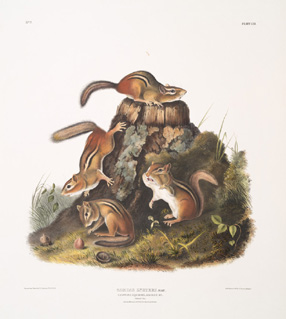|
The Chipmunk’s scientific name is highly descriptive:
the Greek tamias, "a keeper of stores" or "treasurer," refers
to its ability to store food in capacious cheek pouches; striatus,
striped, describes the five black stripes on its back. In Audubon’s
day, this familiar rodent was also known as a chipping squirrel,
and "hackee." Chipmunks are common in many New York City parks and
wild areas, where they excavate deep burrows with multiple entrances.
Their menu is extensive: acorns, other nuts and seeds, fruits, berries,
corn, insects, and even bird eggs.
The creation of Quadrupeds was very much a family enterprise.
Audubon’s co-author, the Reverend Bachman, was also father-in-law
to his sons John Woodhouse, who painted many of the animal portraits,
and Victor, who supervised publication of the large- format first
edition (1845-48) and this subsequent octavo version.
|


